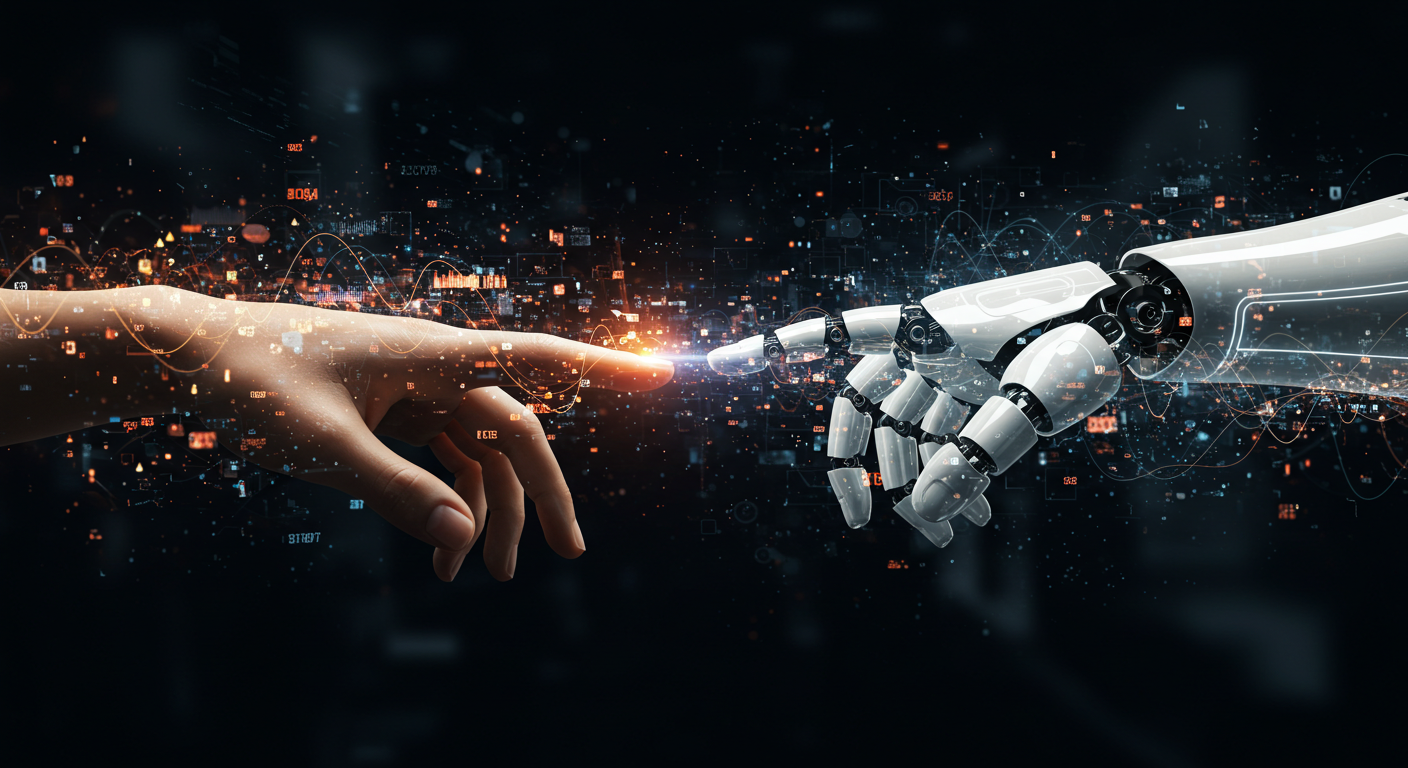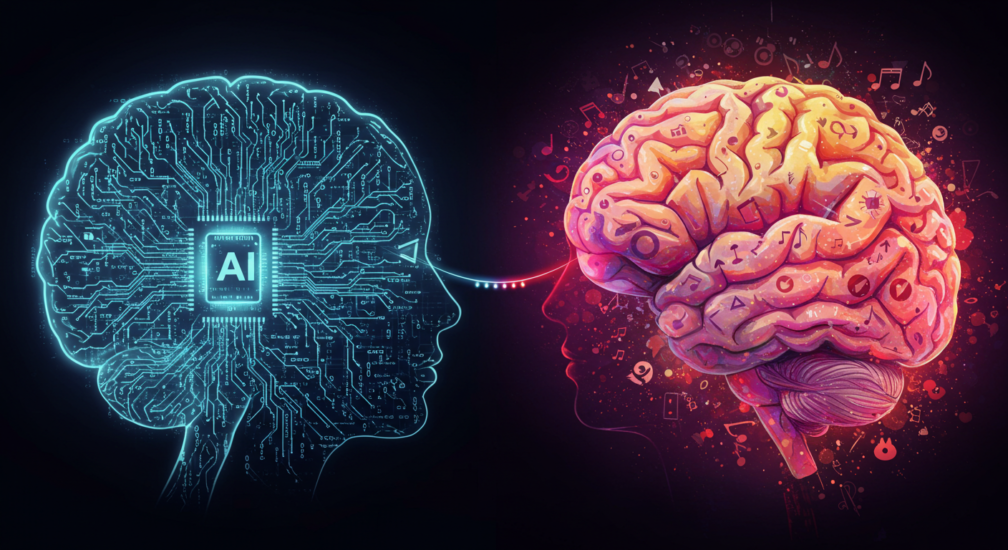When I started my career in technology design over a decade ago, the conversation around Artificial Intelligence was mostly confined to academic papers and science fiction films.
It was a fascinating concept, but one that felt far removed from the daily reality of creating digital products. Fast forward to today, and the conversation is no longer about if AI will impact us, but how.
My entire professional journey has been about watching these two seemingly opposite forces—AI vs. Human Intelligence—begin to converge, not as rivals, but as partners.
For years, the public narrative has positioned these two as competitors in an intellectual showdown. But from where I stand, having worked with AI to build creative systems and solve complex problems, the reality is far more nuanced and, frankly, more exciting.
The true potential lies in understanding the unique strengths and synergy of both to create something greater than either could achieve alone. In this article, I want to share my perspective on this topic, offering insights and a practical roadmap for embracing a future where both forms of intelligence not only coexist but thrive together.
1. Defining the Core Concepts: What Separates AI from Human Cognition?

Before we get to the collaboration, we have to understand the fundamental nature of each player.
Human intelligence is an emergent property of our biological brains, a complex system of cognitive abilities that we use to reason, learn, create, and adapt.
It’s not just about a single function; it’s a holistic, associative process driven by a unique blend of genetics, experience, and environment.
We learn from a few examples, adapt to new contexts on the fly, and use our past experiences to inform our present actions. It’s a messy, beautiful, and deeply personal process.
On the other hand, Artificial Intelligence is a completely different kind of system. It’s a digital creation, based on mathematical models and algorithms.
While it can be designed to mimic human thought, it is fundamentally a system of computation.
The most advanced forms, powered by machine learning and deep learning with architectures like neural networks, can process vast amounts of data to find patterns and make predictions.
Unlike the human brain, AI’s “knowledge” is stored in databases and models, and its learning is primarily driven by exposure to massive datasets.
The nature of AI vs. Human Intelligence starts here: one is an analog, holistic, and embodied system, while the other is a digital, data-driven, and disembodied on
2. The Unmatched Power of AI: Speed, Scale, and Precision
In my work, I’ve seen firsthand where AI is an absolute powerhouse. Its primary advantages are speed, scale, and precision.
AI can perform tasks that would be impossible or incredibly time-consuming for a human. For instance, in the field of data analysis, an AI can sift through terabytes of information in seconds to identify trends or anomalies that would take a team of analysts weeks or months to find.
This ability to handle vast amounts of data is where AI shines. It can execute repetitive tasks with unerring accuracy and without fatigue, making it the perfect tool for automation in industries from manufacturing to finance.
Consider a simple example: building a product recommendation engine. A human team could try to manually tag products and set up rules, but an AI can analyze billions of customer interactions, purchase histories, and product attributes to create a recommendation model that is far more accurate and dynamic.
This leads to increased efficiency and a better user experience. In tasks where data processing and rule-based logic are paramount, AI is not just better—it’s in a class of its own.
3. The Irreplaceable Edge of Human Intelligence: Creativity, Emotion, and Ethics
While AI excels at tasks defined by logic and data, I’ve seen countless examples where human intelligence remains completely irreplaceable.
The single biggest differentiator is our capacity for creativity and intuition. When I’m working with a design team, an AI can help generate thousands of logo variations based on a text prompt, but it cannot conceptualize the “feeling” or “story” we want to convey.
That requires a spark of creativity that comes from a unique blend of life experience, emotions, and personal associations. AI can generate new things, but it lacks the originality that defines true human innovation.
Beyond creativity, there’s emotional intelligence (EQ) and empathy. An AI can be trained on a dataset of faces to recognize anger, but it cannot truly feel anger or understand the nuanced context of a tense conversation.
In my field, understanding a user’s emotional state and building a product that feels intuitive and humane is a critical skill. Similarly, an AI can help doctors analyze medical scans, but it cannot provide the human empathy and comfort a patient needs when they receive a difficult diagnosis.
Finally, there’s ethical judgment and moral reasoning. As we develop AI systems, we’re constantly faced with questions that have no right or wrong answers, only complex trade-offs.
Should a self-driving car prioritize the passenger’s life or the lives of pedestrians in a no-win scenario? An AI can only follow the rules it’s been given. A human, however, can use their moral reasoning to weigh the nuances and make a judgment call. Our adaptability to new situations and our ability to apply a holistic, contextual lens is something AI simply cannot replicate.
4. The Path to Synergy: When AI and Humans Collaborate
This is where the real magic happens. The conversation should not be about AI vs. Human Intelligence, but about how we can merge the strengths of both. This is the synergy that will define the next generation of products and services.
Think of it like this: an AI is an incredible tool, a powerful extension of human thought. The key is to see it as a teammate, not a replacement.
In my design work, AI has become an indispensable assistant. It helps me with the tedious, time-consuming parts of the job, like generating different color palettes or automating repetitive image-editing tasks.
This frees up my time to focus on what I do best: the conceptual work, the strategic thinking, the creative direction, and the human-centered problem-solving. It’s a true human-AI collaboration.
This complementary relationship can be seen across countless industries. In medicine, AI can analyze X-rays and MRIs at an astonishing rate to flag potential issues, but it’s the human doctor who synthesizes that information, applies their years of experience and intuition, and communicates the diagnosis with care and compassion.
In legal settings, an AI can sift through thousands of legal documents in minutes, helping a human lawyer build their case more efficiently. The lawyer still needs to be the one to present the case in court, understand the nuances of a jury, and make an argument based on their personal insight.
5. Practical Applications and the Future of Work
The merging of these two forms of intelligence is fundamentally changing the nature of work. It’s not about AI taking our jobs; it’s about AI changing what our jobs are. Routine, data-driven tasks will continue to be automated, which means the jobs of the future will require uniquely human skills. This highlights the importance of upskilling and reskilling the workforce.
Instead of being an expert in a specific tool, a professional must now be an expert in working with intelligent tools. This requires focusing on skills that AI cannot replicate. For example:
- Critical Thinking and Problem-Solving: The ability to analyze a situation, identify a unique problem, and then use AI as a tool to help solve it.
- Creative Thinking: The human capacity for novel ideas and original thought.
- Emotional Intelligence: The ability to navigate social situations, lead teams, and provide service that is empathetic and human-centered.
The focus of education and professional development will shift from teaching people how to perform tasks to teaching them how to be strategic thinkers who can leverage powerful tools to achieve their goals. A perfect example of this is the ongoing debate about AI vs. Human Intelligence in the creative fields, where AI is seen not as an enemy, but as a new medium for artistic expression.
Conclusion: The Future is a Partnership
In my decade of experience, I’ve watched the AI conversation evolve from one of fear and science fiction to one of pragmatic partnership. There is no doubt that AI will continue to advance, taking on increasingly complex tasks. However, the unique and deeply human qualities of creativity, empathy, and ethical judgment will remain our unique advantage.
The true goal for all of us should be to embrace this synergy, to use AI as a tool to make us more efficient, more creative, and more impactful.
The future belongs not to those who fear the rise of AI, but to those who learn to work alongside it, harnessing its power to solve the biggest challenges facing our world. We should stop asking who will win the showdown and start asking how we can win together.
To learn more about how to design for this new era of intelligent tools and human-centered experiences, visit our blog at DesignersJoint.com.
Frequently Asked Questions
Q1: Will AI replace human jobs?
A: AI is unlikely to completely replace humans, but it will change how we work. It will automate routine and repetitive tasks, freeing up humans to focus on higher-level, more creative, and strategic work that requires emotional intelligence and critical thinking. The jobs of the future will be more collaborative, with humans and AI working as a team.
Q2: What is the biggest difference between AI and human learning?
A: The biggest difference is the source of learning. AI learns from vast amounts of data using algorithms and machine learning models. Humans, on the other hand, can learn from very little data and apply that knowledge to completely new situations based on intuition and past experiences, a concept known as adaptability.
Q3: How can I prepare for a career in an AI-driven world?
A: The best way to prepare is to focus on skills that AI cannot replicate. This includes creativity, problem-solving, emotional intelligence, and critical thinking. It is also important to embrace lifelong learning and continuously upskill and reskill to understand how to work with and manage AI tools.
Q4: Is AI creative?
A: AI can be used to generate novel and unique outputs, but this is based on its ability to recognize and combine patterns from the data it has been trained on. It does not possess genuine creativity in the way humans do, as it lacks the consciousness, lived experience, and emotional depth that drive true human innovation. It is an extraordinary tool for creativity, but not a replacement for the human mind.
Rate post











